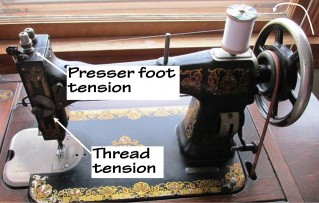Although I learned to sew on my great-grandmother’s Singer treadle machine as a child, I haven’t used a treadle since I was a teen, which was, ah, some time ago.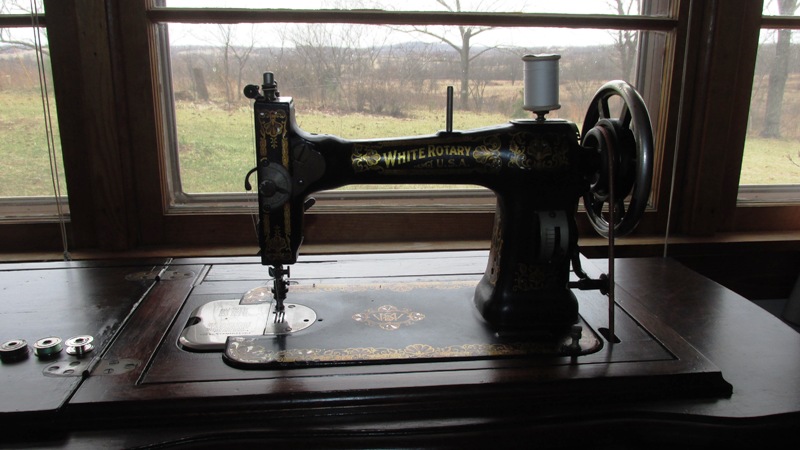
When Darren and I brought home an antique White Family Rotary treadle from a thrift store last year, I thought it would be just like great-granny’s old Singer. After we cleaned it up and doused every moving part with oil, I figured I’d hop on and be stitching away – just like that.
Well, I soon learned the White has one very distinct difference from other treadles. The top of the hand wheel is turned away from the operator to sew. Sure, the wheel will turn toward the front as in other machines, but the thread will bunch up and make an awful mess.
Treadling “backwards” took some getting used to, sort of like driving on the opposite side of the road, but now is a mindless motion.
That was lesson No. 1.
Then, since the machine had only one bobbin, I went online to eBay and bought four “vintage” bobbins in a package from the 1950s or 60s for about $2.50 each. Although they are slightly different in appearance (stamped “Japan”), they work just as well as the original bobbin.
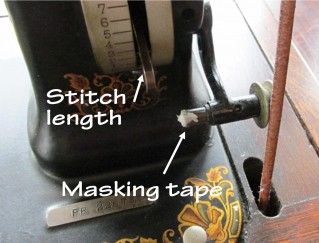
Apply a small piece of masking tape to the bobbin winder shaft if you are using modern bobbins. Reduce the stitch length to 0 or 1 to lock in stitches.
Recently, when I realized I needed many bobbins for different thread weights and colors, I ordered a bargain pack on eBay – 20 bobbins for $15 and free shipping. These bobbins are brand-spanking new and shiny. I’m assuming China-made. In the bobbin case, they work just fine … but, the center hole is larger than the older bobbins, so they spin on the bobbin winder instead of winding on the thread.
That was lesson No. 2.
Darren solved this problem by suggesting I apply a tiny dab of masking tape to the bobbin winder shaft. His solution worked perfectly.
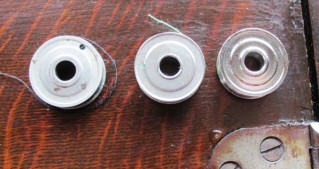
The bobbin on the left is original (from about 1914). The middle bobbin was made in Japan in the 1950s or so. The bobbin on the right is modern, with a slightly larger center hole.
So, yes, you can buy new bobbins instead of the extra cost for antique or vintage bobbins. You can sew with them. However, to save trouble, I recommend finding older bobbins if you can. They are certainly worth the additional cost.
I’ve learned a few other tricks worth mentioning. If you have used an electric machine most of your life as I have, you’ve surely gotten used to modern conveniences, such as automatic forward/backward stitching to lock in your starts/stops. Old treadles stitch only forward.
So, you can make a few stitches (about 1/2 inch), and then pivot on the needle to turn the fabric 180 degrees and reverse your line of stitching back to your starting point. Then stitch forward again. This takes extra time and is awkward when sewing large pieces.
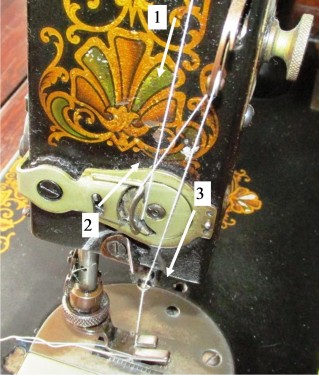
Bring the thread from the spool, through the small wheel at the top of the presser-foot assembly, down to the spring (1), up to the take-up lever (2), and down to the needle (3).
An easier method of locking in your stitches is to start out with very short stitches (I set mine on 0). Stitch about half an inch and then increase the stitch length to about 4. As you near the end of your line of stitching, reduce the stitch length again to 0 or 1 for the last half an inch.
And, since there is no zigzag stitch for finishing seams, I stitch about 1/8 inch away from the seam in places where I fear the fabric could unravel over time. In places of stress or with loosely woven fabric, I’ll make a flat-fell seam, turning under the raw edges. If there is an easier solution, I’d love to hear about it.
So, even without 1,000 stitches to choose from, I absolutely love my old treadle and wouldn’t trade it for all the bobbins in China. The stitches are smooth and uniform, even when sewing through eight layers of heavy denim.
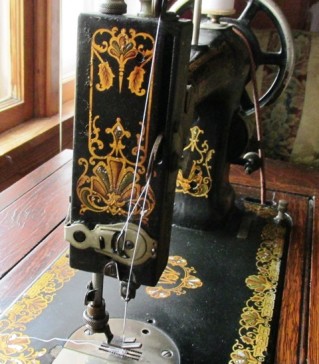 This is also the easiest machine to thread, oil and adjust. With my fancy electric machines, I would often scowl when it was time to rethread or wind a bobbin because it was a nuisance. No longer. Threading the machine takes just a few seconds.
This is also the easiest machine to thread, oil and adjust. With my fancy electric machines, I would often scowl when it was time to rethread or wind a bobbin because it was a nuisance. No longer. Threading the machine takes just a few seconds.
I have not tried out any of the attachments yet for my machine, but will get around to it on the next snowy day. Check back soon to learn more about sewing with a treadle.
To see some of the projects completed on my treadle, click here and here. Also, be sure to see our Homestead Sewn Preps page to purchase our unique, treadle-sewn items to make life easier. Incidentally, we re-purpose quality 100-percent cotton fabric whenever possible, keeping discarded garments from landfills.
© 2013-2014 Well WaterBoy Products LLC ♦ WaterBuck Pump™ ♦ Pedal Powered PTO™

